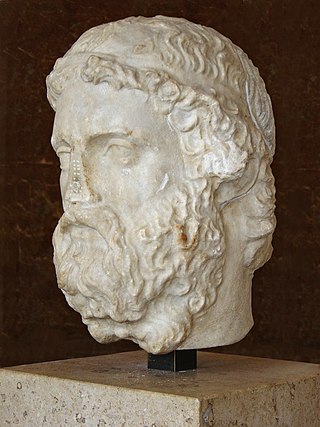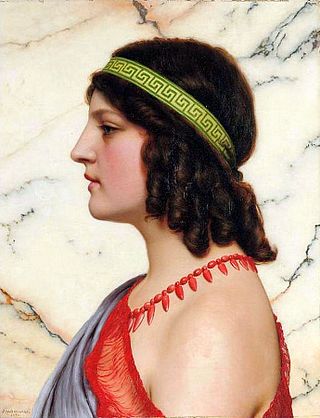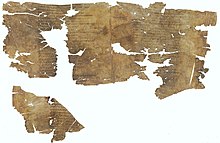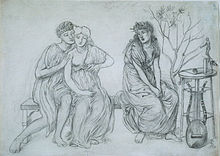
Alcaeus of Mytilene was a lyric poet from the Greek island of Lesbos who is credited with inventing the Alcaic stanza. He was included in the canonical list of nine lyric poets by the scholars of Hellenistic Alexandria. He was a contemporary of Sappho, with whom he may have exchanged poems. He was born into the aristocratic governing class of Mytilene, the main city of Lesbos, where he was involved in political disputes and feuds.

Sappho was an Archaic Greek poet from Eresos or Mytilene on the island of Lesbos. Sappho is known for her lyric poetry, written to be sung while accompanied by music. In ancient times, Sappho was widely regarded as one of the greatest lyric poets and was given names such as the "Tenth Muse" and "The Poetess". Most of Sappho's poetry is now lost, and what is extant has mostly survived in fragmentary form; only the Ode to Aphrodite is certainly complete. As well as lyric poetry, ancient commentators claimed that Sappho wrote elegiac and iambic poetry. Three epigrams formerly attributed to Sappho are extant, but these are actually Hellenistic imitations of Sappho's style.

Alcman was an Ancient Greek choral lyric poet from Sparta. He is the earliest representative of the Alexandrian canon of the Nine Lyric Poets. He wrote six books of choral poetry, most of which is now lost; his poetry survives in quotation from other ancient authors and on fragmentary papyri discovered in Egypt. His poetry was composed in the local Doric dialect with Homeric influences. Based on his surviving fragments, his poetry was mostly hymns, and seems to have been composed in long stanzas made up of lines in several different meters.

The Sapphic stanza, named after Sappho, is an Aeolic verse form of four lines. Originally composed in quantitative verse and unrhymed, since the Middle Ages imitations of the form typically feature rhyme and accentual prosody. It is "the longest lived of the Classical lyric strophes in the West".

Anacreon was a Greek lyric poet, notable for his drinking songs and erotic poems. Later Greeks included him in the canonical list of Nine Lyric Poets. Anacreon wrote all of his poetry in the ancient Ionic dialect. Like all early lyric poetry, it was composed to be sung or recited to the accompaniment of music, usually the lyre. Anacreon's poetry touched on universal themes of love, infatuation, disappointment, revelry, parties, festivals and the observations of everyday people and life.

Telesilla was an ancient Greek lyric poet from Argos, active in the fifth century BC. She is known for her supposed role in the defence of Argos in 494 BC, which is doubted by modern scholars. Only a few fragments of her poetry survive, several of which reference the gods Apollo and Artemis. The longest surviving fragment, only two lines, is quoted by the grammarian Hephaestion to illustrate the Telesillan metre, named after her. She was apparently famous in antiquity, included by Antipater of Thessalonica in his canon of women poets; in the twentieth century she inspired a poem by the imagist poet H.D.

Praxilla of Sicyon, was a Greek lyric poet of the 5th century BC, from Sicyon on the Gulf of Corinth. Eusebius dates her floruit to 451/450 BC. Five quotations and three paraphrases from her poems survive. Three of the poems attributed to her are drinking songs, two are religious, and the three paraphrases are all versions of myths. Various social contexts have been suggested for Praxilla based on this range of surviving works, including that her poetry was in fact composed by two different authors; that Praxilla was a hetaira (courtesan); that she was a professional musician; or that the drinking songs derive from a non-elite literary tradition rather than being authored by a single writer.

Erinna was an ancient Greek poet. She is best known for her long poem The Distaff, a 300-line hexameter lament for her childhood friend Baucis, who had died shortly after her marriage. A large fragment of this poem was discovered in 1928 at Oxyrhynchus in Egypt. Along with The Distaff, three epigrams ascribed to Erinna are known, preserved in the Greek Anthology. Biographical details about Erinna's life are uncertain. She is generally thought to have lived in the first half of the fourth century BC, though some ancient traditions have her as a contemporary of Sappho; Telos is generally considered to be her most likely birthplace, but Tenos, Teos, Rhodes, and Lesbos are all also mentioned by ancient sources as her home.
Aeolic verse is a classification of Ancient Greek lyric poetry referring to the distinct verse forms characteristic of the two great poets of Archaic Lesbos, Sappho and Alcaeus, who composed in their native Aeolic dialect. These verse forms were taken up and developed by later Greek and Roman poets and some modern European poets.
Sappho 31 is an archaic Greek lyric poem by the ancient Greek poet Sappho of the island of Lesbos. The poem is also known as phainetai moi after the opening words of its first line. It is one of Sappho's most famous poems, describing her love for a young woman.

Papyrus Oxyrhynchus 7 is a papyrus found at Oxyrhynchus in Egypt. It was discovered by Bernard Pyne Grenfell and Arthur Surridge Hunt in 1897, and published in 1898. It dates to the third century AD. The papyrus is now in the British Library.

Sappho 16 is a fragment of a poem by the archaic Greek lyric poet Sappho. It is from Book I of the Alexandrian edition of Sappho's poetry, and is known from a second-century papyrus discovered at Oxyrhynchus in Egypt at the beginning of the twentieth century. Sappho 16 is a love poem – the genre for which Sappho was best known – which praises the beauty of the narrator's beloved, Anactoria, and expresses the speaker's desire for her now that she is absent. It makes the case that the most beautiful thing in the world is whatever one desires, using Helen of Troy's elopement with Paris as a mythological exemplum to support this argument. The poem is at least 20 lines long, though it is uncertain whether the poem ends at line 20 or continues for another stanza.

The Ode to Aphrodite is a lyric poem by the archaic Greek poet Sappho, who wrote in the late seventh and early sixth centuries BCE, in which the speaker calls on the help of Aphrodite in the pursuit of a beloved. The poem survives in almost complete form, with only two places of uncertainty in the text, preserved through a quotation from Dionysius of Halicarnassus' treatise On Composition and in fragmentary form in a scrap of papyrus discovered at Oxyrhynchus in Egypt.

The Brothers Poem or Brothers Song is a series of lines of verse attributed to the archaic Greek poet Sappho, which had been lost since antiquity until being rediscovered in 2014. Most of its text, apart from its opening lines, survives. It is known only from a papyrus fragment, comprising one of a series of poems attributed to Sappho. It mentions two of her brothers, Charaxos and Larichos; the only known mention of their names in Sappho's writings, though they are known from other sources. These references, and aspects of the language and style, have been used to establish her authorship.

The midnight poem is a fragment of Greek lyric poetry preserved by Hephaestion. It is possibly by the archaic Greek poet Sappho, and is fragment 168 B in Eva-Maria Voigt's edition of her works. It is also sometimes known as PMG fr. adesp. 976 – that is, fragment 976 from Denys Page's Poetae Melici Graeci, not attributed to any author. The poem, four lines describing a woman alone at night, is one of the best-known surviving pieces of Greek lyric poetry. Long thought to have been composed by Sappho, it is one of the most frequently translated and adapted of the works ascribed to her.

The Tithonus poem, also known as the old age poem or the New Sappho, is a poem by the archaic Greek poet Sappho. It is part of fragment 58 in Eva-Maria Voigt's edition of Sappho. The poem is from Book IV of the Alexandrian edition of Sappho's poetry. It was first published in 1922, after a fragment of papyrus on which it was partially preserved was discovered at Oxyrhynchus in Egypt; further papyrus fragments published in 2004 almost completed the poem, drawing international media attention. One of very few substantially complete works by Sappho, it deals with the effects of ageing. There is scholarly debate about where the poem ends, as four lines previously thought to have been part of the poem are not found on the 2004 papyrus.

Papyrus Oxyrhynchus 1231 is a papyrus discovered at Oxyrhynchus in Egypt, first published in 1914 by Bernard Pyne Grenfell and Arthur Surridge Hunt. The papyrus preserves fragments of the second half of Book I of a Hellenistic edition of the poetry of the archaic poet Sappho.

Sappho 2 is a fragment of a poem by the archaic Greek lyric poet Sappho. In antiquity it was part of Book I of the Alexandrian edition of Sappho's poetry. Sixteen lines of the poem survive, preserved on a potsherd discovered in Egypt and first published in 1937 by Medea Norsa. It is in the form of a hymn to the goddess Aphrodite, summoning her to appear in a temple in an apple grove. The majority of the poem is made up of an extended description of the sacred grove to which Aphrodite is being summoned.

Sappho was an ancient Greek lyric poet from the island of Lesbos. She wrote around 10,000 lines of poetry, only a small fraction of which survives. Only one poem is known to be complete; in some cases as little as a single word survives. Modern editions of Sappho's poetry are the product of centuries of scholarship, first compiling quotations from surviving ancient works, and from the late 19th century rediscovering her works preserved on fragments of ancient papyri and parchment. Along with the poems which can be attributed with confidence to Sappho, a small number of surviving fragments in her Aeolic dialect may be by either her or her contemporary Alcaeus. Modern editions of Sappho also collect ancient "testimonia" which discuss Sappho's life and works.

Sappho 96 is a poem by the archaic Greek lyric poet Sappho. 37 lines of the fragment are preserved on a 6th-century parchment. The first twenty lines describe an imaginary scene in which an unnamed woman is struck by grief remembering an absent companion, Atthis; the remaining 17 lines, possibly originally a separate poem, reflects more generally on the foolishness of trying to compare human and divine beauty. As with other poems by Sappho such as poem 16 and 94, memory is a major theme.


















